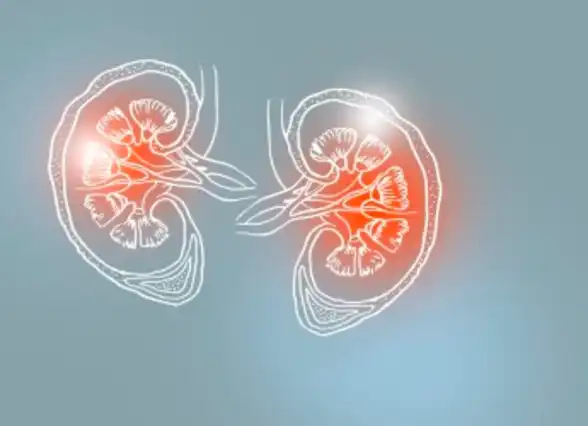Age-Related Renal (Kidney) Decline
Aging contributes to the progressive loss of kidney function, with steady decline beginning around age 40 and accelerated decline after age 65.
Get insurance benefits, legal documents, and medical records in one place

Helpful Highlights
Aging is closely associated with an increased risk of kidney disease, a condition known as age-related renal decline.
As individuals age, there is a natural and gradual decline in kidney function, characterized by structural changes in the kidneys.
Age-related changes make the elderly population more vulnerable to chronic kidney disease (CKD).
Kidney screenings that produce abnormal results may not always indicate increased health risks due to kidney disease.
The aging kidneys
Age-associated loss of kidney function has been recognized for decades, though most people don't realize that, as we age, we lose kidney function.
The kidneys' ability to adequately filtrate blood starts to steadily decline beginning around age 40 and accelerates after age 65.
People over 60 are more likely than not to develop kidney disease.
According to estimates from Johns Hopkins University, more than 50% of people over age 75 are believed to have kidney disease, whether they know it or not.
Older adults may not realize they are at increased risk until it is too late. Everyone over the age of 60 should be screened annually for renal disease.
Age-related changes in the kidneys
Several distinct structural and functional capacity changes occur in the kidneys with age.
Loss of renal mass resulting from a decrease in the number of nephrons - the basic structural and functional units of the kidneys.
Narrowing and hardening of the blood vessels in the kidneys, reducing blood flow.
Narrowing and hardening of the vessels in the glomeruli - the tiny network of blood vessels that are the cleaning units of the kidneys.
Decrease in renal blood flow, which prevents the kidneys from adequately filtering waste products and removing excess fluids.
Decrease in glomerular filtration rate (GFR), a measure that determines how well the kidneys are filtering.
Changes in hormone activity that can cause injury to the kidneys themselves, as well as problems with various bodily systems and functions like blood pressure, bone density, and oxygenation.
Potential problems
Several signs point to problems with kidney function, most notably:
Proteinuria – an elevated level of protein in the urine.
Hematuria – blood in the urine.
Increased creatinine level.
Electrolyte imbalances.
High blood pressure that is difficult to control with medication.
When these symptoms are seen in older patients, physicians may suspect either inflammation of the kidneys (glomerulonephritis), or damaged filtration that leads to large amounts of protein spilling into the urine (nephrotic syndrome).
Chronic kidney disease (CKD)
Chronic kidney disease is defined based on the presence of either kidney damage or decreased kidney function for three or more months, regardless of the cause, and is largely determined by glomerular filtration rate (GFR) and urine contents.
According to current guidelines, a GFR below 60 for three months or longer is considered an indication of chronic kidney disease.
Chronic kidney disease (CKD) in older adults can result from a combination of physiologic, age-related decline in kidney function, comorbidities (other medical conditions), risk factors (lifestyle, family history), and external insults (medications/polypharmacy, environmental agents).
In the U.S., CKD in people aged 65 and older is more common (38%) than in all other age groups, and over the last four decades, patients older than 75 are the fastest-growing group to start dialysis (treatment for end-stage renal disease).
Possibly no cause for alarm
Research published in JAMA (2021) found that many people over 65 with a low GFR and no elevated protein in their urine did not have increased health risks. For people in their 70s and 80s, a low GFR may simply reflect the normal slowing of kidney function with age.
The study concluded that the current criteria for CKD that use the same GFR rates for all ages may result in an overestimation and overdiagnosis of CKD among the elderly, leading to unnecessary interventions in people who merely have an age-related reduction in GFR.
If your loved one is over age 60, they should be screened annually for renal disease, but not jump to conclusions over the results. Results should be thoroughly discussed with your loved one's provider to determine your loved one's health status, level of risk, and subsequent diagnosis (if any).
RESOURCES
Johansen, K.L., Chertow, G.M., Gilbertson, D.T., Herzog, C.A., Ishani, A., Israni, A.K., Ku, E., Li, S., Li, S., Liu, J., Obrador, G.T., O'Hare, A.M., Peng, Y., Powe, N.R., Roetker, N.S., St Peter, W.L., Saeed, F., Snyder, J., Solid, C., Weinhandl, E.D., Winkelmayer, W.C., & Wetmore, J.B. (2022). US Renal Data System 2021 Annual Data Report: Epidemiology of Kidney Disease in the United States. American Journal of Kidney Diseases, 79(4 Suppl 1), A8-A12. DOI
Liu, P., Quinn, R.R., Lam, N.N., Elliott, M.J., Xu, Y., James, M.T., Manns, B., & Ravani, P. (2021). Accounting for age in the definition of chronic kidney disease. JAMA Internal Medicine, 181(10), 1359-1366. DOI
Merchant, A.A., & Ling, E. (2023). An approach to treating older adults with chronic kidney disease. Canadian Medical Association Journal (CMAJ), 195(17), E612-E618. DOI
National Kidney Foundation (NKF)
Weinstein, J.R., & Anderson, S. (2010). The aging kidney: Physiological changes. Advances in Chronic Kidney Disease, 17(4), 302-307. DOI
No content in this app, regardless of date, should ever be used as a substitute for direct medical advice from your doctor or other qualified clinician.
Get more support and guidance on insurance benefits, medical records and legal forms.
Helpful brings together your insurance benefits, legal documents, and medical records in one personalized place — so you always know what you have, and never have to search again.

Technology for Health Tasks. Mental Health for the Tough Stuff.
Helpful connects your medical records, insurance, and caregiving tasks automatically. And when you need more than logistics, a therapist is here to guide you.
In-Network and Covered
For Individuals, Couples and Families
HIPAA Compliant, Data Stays Private






